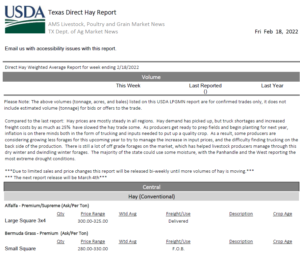USDA publishes a summary of current Texas hay prices every two weeks. This is useful for hay growers and buyers for a snapshot of current prices. The next report will be posted March 4, 2022, at https://www.ams.usda.gov/mnreports/ams_2707.pdf
Reports divide Texas into four regions for pricing: Panhandle, Central, South, and West. The current edition provides current market prices for alfalfa (including different grades of supreme/premium/good), bermudagrass, sorghum (meaning sorghum/sudan, not grain sorghum stalks), and wheat hay.
Some prices are per ton (preferred). Others are based on bale size (large square, small square, round). AgriLife strongly recommends the Texas hay industry—all buyers and sellers—market hay based on weight rather than bale size. Bales even of similar size, especially round bales, can vary by 20% in weight. Hay transactions based on weight are better. The buyer and seller better understand what is being marketed. No guess work, which is not always reliable.
Other Tips for Buying and Selling Hay
Like any market transaction clarity in what is bought and sold is best. This is why we recommend hay sales be based on weight rather than bale or bale size. This is fair. It eliminates guess work. This helps maintain a good relationship between buyer and seller.
Here are additional considerations when buying and selling hay in Texas.
- Is forage nutritive value being tested? This further clarifies what is being bought and sold. I especially recommend hay buyers request permission to take your own forage sample for protein/fiber/nutrient analysis. This protects you from overpaying (or underselling) for forage. Hay quality testing is routine for alfalfa sales. If a prospective seller will not let you test the hay for forage quality before making a decision to buy, then look for another seller if you can.
- It may not be worth forage testing if you are only buying two large round bales, or a dozen small squares. Though this quality analysis is still valuable, it may not be worth the effort.
- Texas A&M AgriLife’s Soil, Water, and Forage Testing Lab, https://soiltesting.tamu.edu/, in College Station and many other labs offer forage testing services.
- If a forage quality analysis is not available or feasible you can still get a visual estimate of relative forage quality. What stage of growth is the forage? For example, a sorghum/sudan hay sample where you can see in the bale the forage was in boot stage (no heading) will be worth more, have more nutritive value vs. hay that is headed out. For alfalfa you can gauge a general estimate of forage nutritive value based on steminess and whether there was any bloom.
- Here is a general guideline on the quality and nutritive value of forages in general. For age quality increases when you move from:
- Grass à Legumes
- Perennial forages à Annual forages
- Warm season forages à Cool season forages
- Mature forages (more advanced state of growth) à Immature forages, especially when still in vegetative stage.
- Traditional annual grass forages for corn, sorghum/sudan (haygrazer), hybrid pearl millet à Brown-mid rib forages of the same crop.
- All hay sales are based on a dry matter basis.
Texas A&M AgriLife county agents and many of our Soil & Crop Sciences faculty are well versed in hay and forage quality pointers for crop production. If you have a question we are happy to visit with you.
Dr. Calvin Trostle, Extension Agronomy, TAMU Dept. of Soil & Crop Sciences, Lubbock, 806-746-6101, ctrostle@ag.tamu.edu
